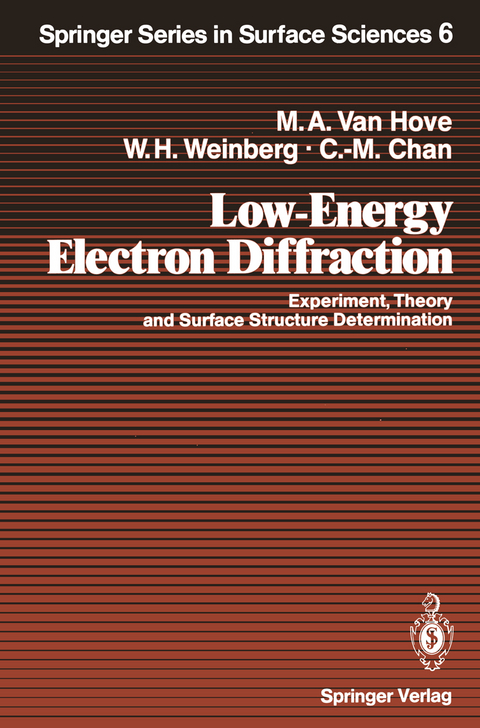
Low-Energy Electron Diffraction
Springer Berlin (Verlag)
978-3-642-82723-5 (ISBN)
1. The Relevance and Historical Development of LEED.- 1.1 The Relevance of Surface Crystallography.- 1.2 The Historical Development of LEED.- 2. The LEED Experiment.- 2.1 General Features of LEED Experiments.- 2.2 Sample Mounting.- 2.3 Electron Gun and Display System.- 2.4 Methods of Data Acquisition.- 2.5 Instrumental Response Function.- 2.6 Determination of Angle of Incidence.- 2.7 Determination of the Debye Temperature.- 3. Ordered Surfaces: Structure and Diffraction Pattern.- 3.1 Two-Dimensional Periodicity and the LEED Pattern.- 3.2 Superlattices at Surfaces.- 3.3 Stepped and Kinked Surfaces.- 3.4 Symmetries and Domains at Surfaces.- 3.5 Interpretation of LEED Patterns.- 4. Kinematic LEED Theory and Its Limitations.- 4.1 Definition of Kinematic Theory.- 4.2 The Kinematic Structure Factor for Ordered Surfaces.- 4.3 The Scattering Processes in LEED.- 4.4 The Elastic Scattering Potential.- 4.5 Atomic Scattering.- 4.6 The Inner Potential and the Muffin-Tin Constant.- 4.7 Temperature Effects.- 4.8 From Kinematic to Dynamical LEED.- 5. Dynamical LEED Theory.- 5.1 Multiple Scattering.- 5.2 Diffraction in Crystalline Lattices.- 5.3 Multiple Scattering in the Spherical-Wave Representation - Self-Consistent Formalism.- 5.4 Perturbation Expansion of Multiple Scattering in the Spherical-Wave Representation: Reverse-Scattering Perturbation (RSP) Method.- 5.5 Diffraction by a Stack of Layers: Transfer-Matrix and Bloch-Wave Method.- 5.6 Diffraction by a Stack of Layers: Layer-Stacking and Layer-Doubling Method.- 5.7 Diffraction by a Stack of Layers: Renormalized-Forward-Scattering (RFS) Perturbation Method.- 5.8 Efficiency of Computation and the Combined-Space Method.- 5.9 Superlattices and Domains.- 5.10 Symmetries.- 5.11 Thermal Effects.- 5.12 Potential Steps, Surface States,Surface Resonances and LEED Fine Structure.- 5.13 Relativistic and Spin-Dependent Effects in LEED.- 5.14 Some Other Theoretical Techniques.- 5.15 Outstanding Theoretical Problems in LEED.- 5.16 Application of LEED Theory to Other Electron Spectroscopies.- 5.17 Computer Programs.- 6. Methods of Surface Crystallography by LEED.- 6.1 The Kinematic Approach to Surface Crystallography.- 6.2 Averaging Methods.- 6.3 Fourier-Transform Methods.- 6.4 The Dynamical Approach to Surface Crystallography.- 6.5 Reliability Factors (R-Factors).- 6.6 Accuracy and Precision of Structural Determination.- 7. Results of Structural Analyses by LEED.- 7.1 Clean Unreconstructed Surfaces.- 7.2 Reconstructed Surfaces.- 7.3 Adsorbed Atomic Layers.- 7.4 Adsorbed Molecular Layers.- 8. Two Dimensional Order-Disorder Phase Transitions.- 8.1 Introduction to Order-Disorder Phase Transitions at Surfaces...- 8.2 The Interaction of Hydrogen with the (111) Surface of Nickel.- 8.3 The Interaction of Hydrogen with the (100) Surface of Palladium.- 8.4 The Interaction of Hydrogen with the (110) Surface of Iron.- 9. Chemical Reactions at Surfaces and LEED.- 9.1 Monitoring Surface Reactions by LEED.- 9.2 The Adsorption of Oxygen on Rh(111) at 335 K.- 9.3 The Reaction Between Hydrogen and Ordered Oxygen on Rh(111).- 9.4 The Reaction Between Hydrogen and Both Ordered and Disordered Oxygen on Rh(111).- 10. Island Formation of Adspecies and LEED.- 10.1 The Nature of Islands on Surfaces.- 10.2 LEED Beam Profiles for Arrays of Ordered Islands.- 10.3 Island Formation in a Real System: CO on Ru(0001).- 11. The Future of LEED.- 11.1 Experimental Outlook.- 11.2 Theoretical Outlook.- 11.3 Progress in Structural Determination.- 11.4 LEED vs. Other Surface-Sensitive Techniques.- 12. Reference List and Table for Surface Structures.- Appendix A: Acronyms of Techniques Related to Surface Science.- Appendix B: A Computer Program to Determine the Angle of Incidence in LEED.- List of Major Symbols.- References.
| Erscheint lt. Verlag | 15.12.2011 |
|---|---|
| Reihe/Serie | Springer Series in Surface Sciences |
| Zusatzinfo | XVIII, 604 p. |
| Verlagsort | Berlin |
| Sprache | englisch |
| Maße | 155 x 235 mm |
| Gewicht | 930 g |
| Themenwelt | Naturwissenschaften ► Chemie ► Physikalische Chemie |
| Naturwissenschaften ► Physik / Astronomie ► Atom- / Kern- / Molekularphysik | |
| Naturwissenschaften ► Physik / Astronomie ► Festkörperphysik | |
| Naturwissenschaften ► Physik / Astronomie ► Theoretische Physik | |
| Technik ► Maschinenbau | |
| Schlagworte | catalysis • Chemistry • Crystal • crystallography • electron • EXAFS • LEED • metals • scattering • solid-state physics • Structure • Surface Science |
| ISBN-10 | 3-642-82723-3 / 3642827233 |
| ISBN-13 | 978-3-642-82723-5 / 9783642827235 |
| Zustand | Neuware |
| Haben Sie eine Frage zum Produkt? |
aus dem Bereich


